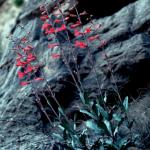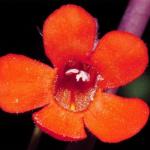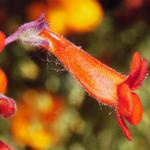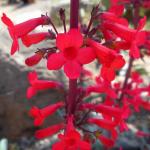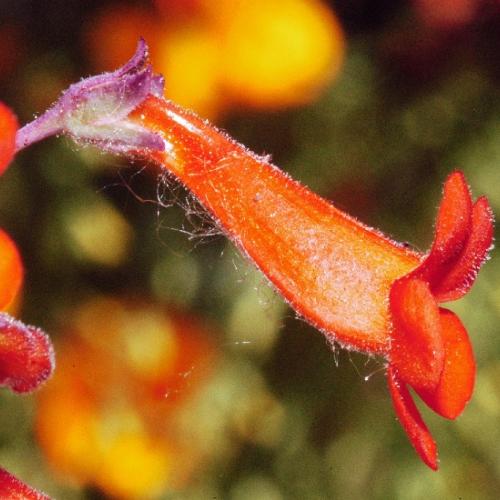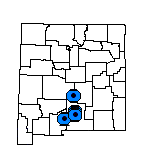Description
Perennial; stems solitary or few, glabrous, 3-7 dm tall; leaves entire, opposite, basal leaves elliptic to lanceolate, stem leaves much reduced, 2-4 pairs, sessile, lanceolate; inflorescence slightly glandular, more orless secund, usually as much as half the plant height; calyx lobes slightly glandular, 3-5 mm long, ovate to lanceolate, acute or acuminate, narrowly scarious; corolla bright red, 20-25 mm long, slightly bilaterally symmetrical, lightly glandular outside, throat gradually and very moderately inflated, lobes 3-6 mm long, spreading; stamens included; anthers glabrous, explanate; staminode glabrous, tip not expanded. Flowers April to June.
Similar Species
Although this plant is not likely to be mistaken for anything else, two other red-flowered beardtongues, Penstemon cardinalis and P. barbatus, are known to grow in the same area as P. alamosensis. The flowers of P. cardinalis, another endemic, are also nearly regular, but are constricted at the orifice (not constricted in P. alamosensis), have long yellow hairs at the base of the lower lobes (glabrous in P. alamosensis), and the anthers do not open across the connective (explanate in P. alamosensis). The flowers in P. barbatus, a widespread species, are markedly bilaterally symmetrical with the upper lobes projecting and the lower reflexed, the base of the lower lobes is hairy, and the anthers are not explanate. Penstemon barbatus flowers later in the year (June-September) than P. alamosensis.
Distribution
New Mexico, Dona Ana, Lincoln, and Otero counties, west escarpment of the Sacramento Mountains and east side of San Andres Mountains; Texas, El Paso County, Hueco Mountains.
Habitat
Sheltered rocky areas, canyon sides and bottoms, on limestone; 1,300-1,620 m (4,300-5,300 ft).
Conservation Considerations
This beautiful, conspicuous plant may be susceptible to collecting in a few frequently visited places. Otherwise, its habitats are relatively inaccessible and current land uses apparently pose no threat to this species.
Important Literature
*New Mexico Native Plants Protection Advisory Committee. 1984. A handbook of rare and endemic plants of New Mexico. University of New Mexico Press, Albuquerque.
*Heflin, J. 1997. Penstemons: The beautiful beardtongues of New Mexico. Jackrabbit Press, Albuquerque, New Mexico.
Straw, R.M. 1997. Penstemon. In: J. Henrickson and M.C. Johnston, eds. A flora of the Chihuahuan Desert region. Draft copy published by J. Henrickson, Los Angeles, California.
Nisbet, G.T. and R.C. Jackson. 1960. The genus Penstemon in New Mexico. University of Kansas Science Bulletin 41(5):691-759.
Spellenberg, R.M. 1981. Status report, Penstemon alamosensis. For U.S. Fish and Wildlife Service, Albuquerque, New Mexico.

